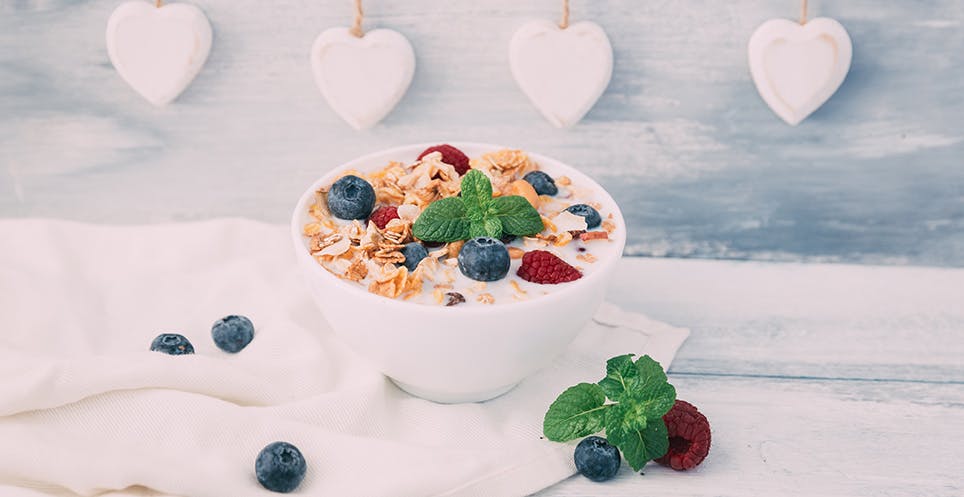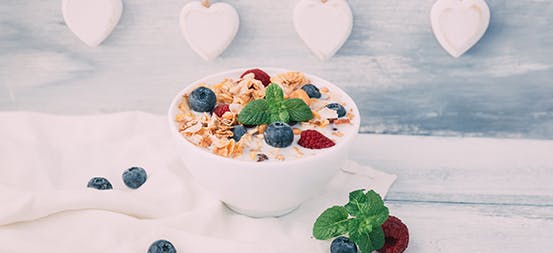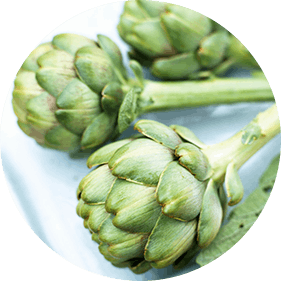7 Healthy Ways to Add Fiber to Your Diet
Cook with whole foods.


Chances are you know that fiber is good for you—and that adding fiber to your daily routine is a great way to manage a healthy weight and support long-term health. Still, if you're like most people, you could probably use more fiber in your diet. USDA guidelines call for 14 grams of dietary fiber in every 1,000 calories consumed.1 That means the typical adult should have between 21 and 38 grams of fiber per day, depending on age and activity level.2*
Sound like a lot? Then consider these tips for adding fiber to your diet:
1.Plan ahead.
Stock your shelves with high-fiber foods and you'll be less apt to grab unhealthy alternatives. The key to good meal planning is your shopping list. At the beginning of each week, take a few minutes to map out your meals, being sure to focus on fiber-rich choices. Later, as the week unfolds, feel free to be flexible. With your fridge stuffed with fresh fruits and vegetables, and your pantry packed with healthy snacks, you can't go wrong.
2.Begin with breakfast.
You've heard it before: Healthy eating starts with a healthy breakfast. If you like boxed cereals, read the labels and pick whole grain options with five or more grams of fiber per serving. Take it a step further by adding a spoonful of wheat bran or a small scoop of fiber supplement. Other good options: oatmeal, whole-wheat pancakes, and fruit.
3. Eat fruit and avoid fruit juices.
One medium-size banana contains three grams of fiber; so does an orange, while an apple holds four grams of fiber.3 A half-cup of apple juice, on the other hand, contains a negligible amount of dietary fiber but more calories than its off-the-tree counterpart.3 The reason: The juicing process strips out the fiber.4 For a high-fiber alternative to fruit juice, use a blender to make a delicious smoothie out of whole fruit and yogurt. And don't worry if your fruit's not fresh. Canned or frozen works just as well.5
4. Choose healthy, high-fiber snacks.
Air-popped popcorn, whole fruits (see #3), or raw vegetables are great options.6 Or grab a handful of almonds, pecans, or pistachio nuts, all of which are loaded with fiber. Save the chips and sugary treats for special occasions, and if you're going to eat crackers, choose whole grain varieties.
5. Cook with whole grains and whole foods.
Wild rice, whole wheat spaghetti, multigrain bread, and baked potatoes are all good places to start.7 Unprocessed foods tend to be high-fiber foods, so choose items that are as close as possible to what you might find in nature.8 And when you're so pressed for time that the only reasonable option is to buy your meal in a box? Read the label.
6. Eat less meat and more legumes.
Cooked lentils and beans are among the best foods you can eat when it comes to finding fiber. One serving of lentils contains more than 15 grams of fiber. So does a cup of cooked split peas.3 Meat, meanwhile, contains no fiber at all.3 You don't have to become a vegetarian, but try substituting high-protein, high-fiber legumes for meats like beef, chicken, and turkey in at least three meals per week. Some bean-filled and healthy meals: lentil soup, chili, and rice-and-bean tacos.
7. Include a fiber supplement in your daily routine.
Benefiber® Original contains three grams of dietary fiber per serving. Add some to your smoothie or sprinkle some on top of your morning bowl of cereal, and before you know it you'll have all the fiber you need.
*According to the Institute of Medicine, it is recommended that, in adults 50 or younger, women should consume 25 grams of fiber daily and men 38 grams. In adults 51 or older, women should consume 21 grams of fiber daily and men 30 grams.
- "U.S. Dietary Guidelines for Americans." Encyclopedia of School Health 2015-2020 8 (2015): 97. U.S. Department of Health, Dec. 2015. Web. https://health.gov/dietaryguidelines/2015/resources/2015-2020_Dietary_Guidelines.pdf.
- "Fiber: Daily Recommendations for Adults." Mayo Clinic. 22 Sept. 2015. Web. http://www.mayoclinic.org/healthy-lifestyle/nutrition-and-healthy-eating/in-depth/fiber/art-20043983?pg=2.
- "Basic Report: Food Search." National Nutrient Database. United States Department of Agriculture, Web. https://ndb.nal.usda.gov/ndb/search/list.
- Zeratsky, Katherine. "Is Juicing Healthier than Eating Whole Fruits or Vegetables?" Mayo Clinic. N.p., 16 July 2016. Web. http://www.mayoclinic.org/healthy-lifestyle/nutrition-and-healthy-eating/expert-answers/juicing/faq-20058020.
- "Review Nutritional Comparison of Fresh, Frozen, and Canned Fruits and Vegetables II. Vitamin A and Carotenoids, Vitamin E, Minerals and Fiber." Journal of the Science of Food and Agriculture 7.87. Web. http://cekings.ucdavis.edu/files/19188.pdf, http://onlinelibrary.wiley.com/doi/10.1002/jsfa.2824/full.
- "Chart of High-fiber Foods." Mayo Clinic. 8 Oct. 2015. Web. http://www.mayoclinic.org/healthy-lifestyle/nutrition-and-healthy-eating/in-depth/high-fiber-foods/art-20050948.
- "Whole Grains and Fiber." American Heart Association. 11 Oct. 2016. Web. http://www.heart.org/HEARTORG/HealthyLiving/HealthyEating/HealthyDietGoals/Whole-Grains-and-Fiber_UCM_303249_Article.jsp#.WO-UNrbyuYV.
- Robinson, Lawrence, and Robert Segal. "High-Fiber Foods." Helpguide.org. Apr. 2017. Web. https://www.helpguide.org/articles/healthy-eating/high-fiber-foods.htm.
Nourish the Goodness Inside
Benefiber is an easy way to add fiber to your life.
$1.50 OFF BENEFIBER






